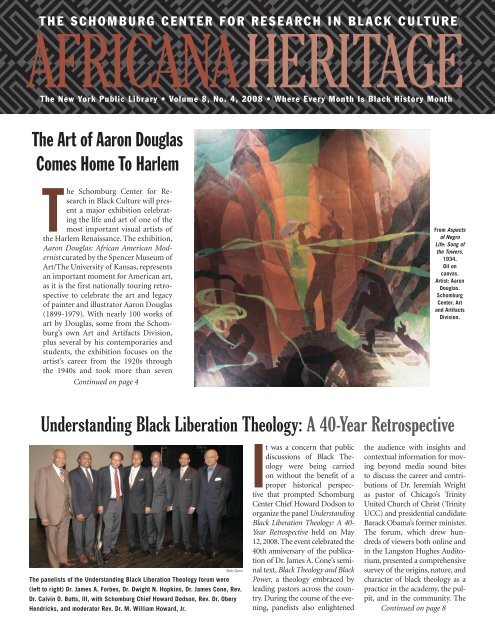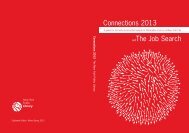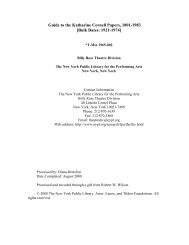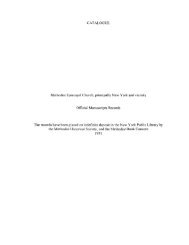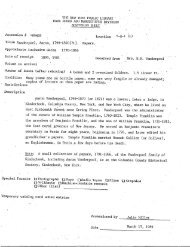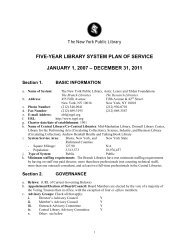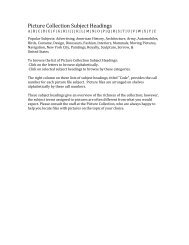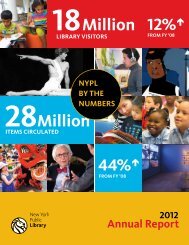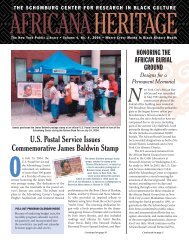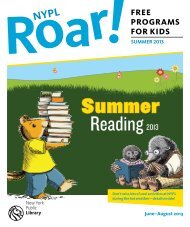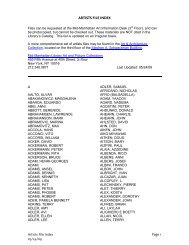Understanding Black Liberation Theology: A 40-Year Retrospective
Understanding Black Liberation Theology: A 40-Year Retrospective
Understanding Black Liberation Theology: A 40-Year Retrospective
You also want an ePaper? Increase the reach of your titles
YUMPU automatically turns print PDFs into web optimized ePapers that Google loves.
T h e S c h o m b u r g C e n t e r f o r R e s e a r c h i n B l a c k C u lt u r e<br />
Africana Heritage<br />
The New York Public Library • Volume 8, No. 4, 2008 • Where Every Month Is <strong>Black</strong> History Month<br />
The Art of Aaron Douglas<br />
Comes Home To Harlem<br />
The Schomburg Center for Research<br />
in <strong>Black</strong> Culture will present<br />
a major exhibition celebrating<br />
the life and art of one of the<br />
most important visual artists of<br />
the Harlem Renaissance. The exhibition,<br />
Aaron Douglas: African American Modernist<br />
curated by the Spencer Museum of<br />
Art/The University of Kansas, represents<br />
an important moment for American art,<br />
as it is the first nationally touring retrospective<br />
to celebrate the art and legacy<br />
of painter and illustrator Aaron Douglas<br />
(1899-1979). With nearly 100 works of<br />
art by Douglas, some from the Schomburg’s<br />
own Art and Artifacts Division,<br />
plus several by his contemporaries and<br />
students, the exhibition focuses on the<br />
artist’s career from the 1920s through<br />
the 19<strong>40</strong>s and took more than seven<br />
Continued on page 4<br />
From Aspects<br />
of Negro<br />
Life: Song of<br />
the Towers,<br />
1934.<br />
Oil on<br />
canvas.<br />
Artist: Aaron<br />
Douglas.<br />
Schomburg<br />
Center, Art<br />
and Artifacts<br />
Division.<br />
<strong>Understanding</strong> <strong>Black</strong> <strong>Liberation</strong> <strong>Theology</strong>: A <strong>40</strong>-<strong>Year</strong> <strong>Retrospective</strong><br />
Bob Gore<br />
The panelists of the <strong>Understanding</strong> <strong>Black</strong> <strong>Liberation</strong> <strong>Theology</strong> forum were<br />
(left to right) Dr. James A. Forbes, Dr. Dwight N. Hopkins, Dr. James Cone, Rev.<br />
Dr. Calvin O. Butts, III, with Schomburg Chief Howard Dodson, Rev. Dr. Obery<br />
Hendricks, and moderator Rev. Dr. M. William Howard, Jr.<br />
It was a concern that public<br />
discussions of <strong>Black</strong> <strong>Theology</strong><br />
were being carried<br />
on without the benefit of a<br />
proper historical perspective<br />
that prompted Schomburg<br />
Center Chief Howard Dodson to<br />
organize the panel <strong>Understanding</strong><br />
<strong>Black</strong> <strong>Liberation</strong> <strong>Theology</strong>: A <strong>40</strong>-<br />
<strong>Year</strong> <strong>Retrospective</strong> held on May<br />
12, 2008. The event celebrated the<br />
<strong>40</strong>th anniversary of the publication<br />
of Dr. James A. Cone’s seminal<br />
text, <strong>Black</strong> <strong>Theology</strong> and <strong>Black</strong><br />
Power, a theology embraced by<br />
leading pastors across the country.<br />
During the course of the evening,<br />
panelists also enlightened<br />
the audience with insights and<br />
contextual information for moving<br />
beyond media sound bites<br />
to discuss the career and contributions<br />
of Dr. Jeremiah Wright<br />
as pastor of Chicago’s Trinity<br />
United Church of Christ (Trinity<br />
UCC) and presidential candidate<br />
Barack Obama’s former minister.<br />
The forum, which drew hundreds<br />
of viewers both online and<br />
in the Langston Hughes Auditorium,<br />
presented a comprehensive<br />
survey of the origins, nature, and<br />
character of black theology as a<br />
practice in the academy, the pulpit,<br />
and in the community. The<br />
Continued on page 8
f r o m t h e Chief<br />
More than 80 years have passed since the Harlem<br />
Renaissance peaked in the mid-1920s.<br />
Nevertheless, the legacy of the Harlem<br />
Renaissance—as much myth as fact—lives<br />
on. The leading writers of the Renaissance—Hughes,<br />
Cullen, Hurston, McKay, to mention only a few—<br />
have become part of the cannon of American literature.<br />
Its musical giants—Ellington, Henderson, Calloway,<br />
etc. are still revered by blacks and whites alike.<br />
Its visual artists, on the other hand, have suffered a<br />
different fate, perhaps because the real flowering in<br />
visual arts did not occur until the era of the Great<br />
Depression in the 1930s. The pioneers of the Renaissance’s<br />
visual arts expression were there in the midto-late<br />
twenties, however, along with the writers and<br />
the musicians. Ironically, many of the visual artists<br />
have become invisible or forgotten.<br />
Aaron Douglas was one of those pioneers —<br />
perhaps the preeminent pioneer. He arrived in<br />
The Schomburg Center is doing its part<br />
to keep the spirit of the Renaissance<br />
alive, especially in the fields of literature,<br />
and the performing and visual arts.<br />
— Howard Dodson, Schomburg Chief<br />
Harlem in 1924 from Kansas, bringing with him a<br />
developed artistic talent. He went to work as an artist<br />
almost immediately and quickly put his visual and<br />
graphic imprint on the movement. Within a year<br />
of his arrival, his work had appeared in the Crisis<br />
and Opportunity magazines, the two most vocal<br />
proponents of the Renaissance. When Alain Locke<br />
looked for an artist to illustrate, his now classic of<br />
the Renaissance, The New Negro in 1925, he turned<br />
to Douglas. It was as a muralist, however, that he<br />
would establish himself as the leading artist of the<br />
Renaissance. Over 80 years later, he is finally being<br />
recognized as the pioneering artist that he was.<br />
Aaron Douglas: African American Modernist is the<br />
first ever major retrospective of Aaron Douglas, the<br />
leading Harlem Renaissance visual artist. Comprised<br />
of some 100 works, the exhibition was organized<br />
by the Spencer Museum of Art at the University of<br />
Kansas, and curated by Dr. Susan Earle, Curator<br />
of the Spencer. Over the last year, the exhibition<br />
has traveled from the Spencer to the Frist Center<br />
for Visual Arts in Nashville, Tennessee and the<br />
Smithsonian American Art Museum. The Schomburg<br />
Center is pleased to welcome Aaron Douglas and his<br />
art back to Harlem. We also welcome his signature<br />
mural series, “Aspects of Negro Life” which have been<br />
the centerpiece of the exhibition, back to their home<br />
at the Schomburg Center. As we celebrate the return<br />
of Aaron Douglas, we also commemorate the life and<br />
departure of one of the stellar leaders of the second<br />
Harlem Renaissance, Dr. Barbara Ann Teer, Founder<br />
and CEO of Harlem’s National <strong>Black</strong> Theater. She<br />
made her transition on July 21 in the <strong>40</strong> th year of the<br />
Theater’s founding.<br />
The seeds of still another Harlem intellectual<br />
renaissance were planted this summer during a sixweek<br />
Summer Institute in the Humanities funded<br />
by the Andrew W. Mellon Foundation. This issue of<br />
Africana Heritage, reports on the results of this path<br />
breaking program for rising seniors from New York<br />
City colleges and universities and Historically <strong>Black</strong><br />
Colleges and Universities.<br />
The Schomburg Center is doing its part to<br />
keep the spirit of the Renaissance alive, especially<br />
in the fields of literature, the performing and visual<br />
arts. It is estimated that during an average month<br />
in contemporary Harlem, the cultural institutions<br />
produce and present more art than occurred in the<br />
entirety of the Harlem Renaissance. This season’s<br />
public programs calendar includes some of the<br />
Schomburg Center’s contributions to the vitality<br />
of contemporary Harlem’s cultural life. I especially<br />
invite your attention to the literary series The<br />
Schomburg Reading Room: Writers on the Cutting Edge<br />
that starts in September and runs through May. I also<br />
encourage you to check out the literary and musical<br />
tributes to Aaron Douglas included in this season’s<br />
program lineup. And don’t miss the exhibition Aaron<br />
Douglas: African American Modernist as we welcome<br />
him back “Home to Harlem.”<br />
2 Africana Heritage • Volume 8, No. 4, 2008 • Where Every Month Is <strong>Black</strong> History Month
I N M E M O R I A M :<br />
Barbara Ann Teer<br />
1937-2008<br />
Primarily known as the founder of<br />
the National <strong>Black</strong> Theater (NBT) in<br />
Harlem in 1968, Barbara Ann Teer<br />
was a Harlem fixture who advocated<br />
for black artists, and specifically for the<br />
development and advancement of black<br />
theater. Born in East St. Louis, Dr. Teer<br />
earned a BA in dance from the University<br />
of Illinois, Urbana-Champaign. She moved<br />
to New York City in the 1960s and taught<br />
at the Wadleigh Junior High School, while<br />
pursuing a career in the arts. As a dancer she<br />
toured with Alvin Ailey Dance Company,<br />
Louis Johnson Dance Company, and the<br />
Pearl Bailey Las Vegas Revue. As an actor, she<br />
studied with Lloyd Richards and appeared<br />
in a number of Broadway and off-Broadway<br />
productions, and was awarded a Drama<br />
Desk Award and several Obie Awards.<br />
In 1963 she co-founded the Group Theatre<br />
Workshop with Robert Hooks. It was during<br />
her tenure as an actor that she became deeply<br />
discouraged by the lack of opportunities for<br />
growth and creativity afforded blacks in<br />
mainstream theatre. “[<strong>Black</strong>s] must begin<br />
building cultural centers where we can enjoy<br />
being free, open and black,” Dr. Teer wrote in<br />
the New York Times in 1968. The same year<br />
she purchased a city block of property in<br />
Central Harlem at 125 th and Fifth Avenue,<br />
On Thursday June 19, 2008 the<br />
Schomburg Center for Research in<br />
<strong>Black</strong> Culture honored its committed<br />
group of volunteers at the annual Volunteer<br />
Recognition Day event. In opening remarks,<br />
Schomburg Chief Howard Dodson<br />
expressed his appreciation to the volunteers<br />
not only for their “service and commitment,”<br />
but also for their “presence” at the Center on<br />
a daily basis. Volunteer Coordinator, Carmen<br />
Matthew likewise praised the volunteers’<br />
efforts and announced that collectively<br />
they served a remarkable 4,250 hours this<br />
year. Special recognition was given to the<br />
following volunteers who served more than<br />
250 hours from July 1, 2007 to June 20, 2008:<br />
W. Carey Byrd<br />
Rose Ketcham<br />
Anita King<br />
Carmen Matthew<br />
which became the home of the NBT, the<br />
first revenue generating black theater arts<br />
complex in the United States.<br />
For <strong>40</strong> years, her work with the<br />
NBT resulted in hundreds of shows,<br />
special events, lectures, art exhibitions,<br />
workshops, and classes which centered<br />
on, embraced, and affirmed black identity<br />
and its African origins. Dr. Teer received<br />
honorary doctorates from the University of<br />
Rochester and Southern Illinois University<br />
acknowledging her achievements in the<br />
arts. She was married briefly to the late<br />
actor Godfrey Cambridge (d.1976.) Dr. Teer<br />
is survived by her two children, Michael<br />
Lythcott and Barbara A. Lythcott.<br />
Center Honors Dedicated Volunteers<br />
National <strong>Black</strong> Theater<br />
Calvin Bass<br />
Schomburg Center’s Christopher Moore leads the<br />
Center’s Volunteers on a walking tour of historical<br />
black sites in Brooklyn, NY.<br />
The entire Schomburg Center staff extends<br />
our sincerest appreciation to these and all<br />
of our volunteers. The staff also joins our<br />
volunteers in remembering and honoring the<br />
memories of Mr. James Lawrence, Ms. Elyse<br />
Sinclair, and Ms. Corrine R. Butler.<br />
Scholars-in-Residence<br />
Class of 2008-2009<br />
National Endowment<br />
for the Humanities<br />
Brown, Carolyn Anderson.<br />
Associate Professor, Department<br />
of History, Rutgers University.<br />
Project: Militant Mineworkers,<br />
Respectable Clerks and Unruly<br />
Youth: Honor and Urban<br />
Masculinity in the Radicalization<br />
of Enugu Nigeria 1939-1955<br />
Foy, Anthony S. Assistant<br />
Professor, Department of English<br />
Literature, Swarthmore College.<br />
Project: <strong>Black</strong> Ideography:<br />
Autobiography, Ideology, Image<br />
Gershenhorn, Jerry Bruce.<br />
Associate Professor, Department<br />
of History, North Carolina<br />
Central University, Durham.<br />
Project: The Freedom of Africa<br />
Depends on Us: African American<br />
Scholars and the Development of<br />
African Studies Programs in the<br />
US, 1942-1960<br />
Guerron-Montero, Carla Maria.<br />
Assistant Professor, Department<br />
of Anthropology, University of<br />
Delaware.<br />
Project: Like an Alien in We<br />
Own Land: Tourism and the<br />
Construction of National and<br />
Transnational Afro-Antillean<br />
Identities in Panama<br />
Mathes, Carter Alexander.<br />
Assistant Professor, Department<br />
of English, Rutgers University<br />
New Brunswick.<br />
Project: Imagine the Sound: <strong>Black</strong><br />
Radicalism and Experimental<br />
Form in Post-1965 African-<br />
American Literary Culture<br />
Woodard, Laurie Avent.<br />
Lecturer, Department of African<br />
American Studies and History,<br />
Yale University.<br />
Project: Astonishingly Pretty for<br />
a Real Negro Girl: Resistance,<br />
Identity, and Meaning in the life<br />
and work of Fredi Washington<br />
during the New Negro<br />
Renaissance, 1920-1950<br />
Africana Heritage • Volume 8, No. 4, 2008 • Where Every Month Is <strong>Black</strong> History Month 3
H e r i t a g e Watch<br />
Opportunity Art<br />
Folio, 1926,<br />
relief print and<br />
letter press;<br />
cover and six<br />
sheets. Spencer<br />
Museum of Art,<br />
The University<br />
of Kansas<br />
Museum<br />
purchase: The<br />
Helen Foresman<br />
Spencer Art<br />
Acquisition<br />
Fund, the<br />
Office of the<br />
Chancellor, and<br />
the Lucy Shaw<br />
Schultz Fund,<br />
2003.0012.01-<br />
.07<br />
In 1926, Douglas collaborated with the poet and fellow<br />
Kansan Langston Hughes on a group of six prints for<br />
Opportunity. Their image-and-text collaboration proved<br />
so popular that Opportunity made the prints available to<br />
subscribers in the form of an art folio. Douglas’s angular,<br />
silhouetted forms are starkly rendered, reminiscent of both<br />
German Expressionist art and the rhythms and content of<br />
the blues, creating a visual equivalent to Hughes’s poems.<br />
Cover for Arthur Huff Fauset, For Freedom: A Biographical Story<br />
of the American Negro, 1927. Collection of Thomas H. Wirth<br />
The Art of Aaron Douglas Comes Home To Harlem<br />
Continued from page 1<br />
years to create.<br />
Born to laborer parents in Topeka,<br />
Kansas, Douglas overcame many obstacles<br />
to pursue his passion for art and ideas.<br />
After earning a BFA degree in 1922 from<br />
the University of Nebraska and teaching<br />
at Lincoln High School in Kansas City, he<br />
migrated to New York in 1925 to join the<br />
cultural flourishing, now widely known as<br />
the Harlem Renaissance. He later moved<br />
to Nashville, Tennessee to create the art<br />
department at Fisk University and taught at<br />
the historically black university for 29 years.<br />
Throughout the 1920s, visual artists as well<br />
as authors, playwrights, philosophers, and<br />
musicians flocked to a roughly two-square<br />
mile section of upper Manhattan known<br />
as Harlem. Stretching from 114th Street to<br />
156th Street, this previously little known<br />
part of New York flourished as the capital<br />
of the African-American social and cultural<br />
scene. As the poet and author Langston<br />
Hughes wrote, “Harlem was in vogue.”<br />
The creative crowd that Douglas met<br />
in Harlem believed that art and creative<br />
expression could help bridge the chasm<br />
between the African-American and white<br />
worlds. These pioneers helped make real the<br />
notion of a self-determined “New Negro”<br />
who possessed an appreciation for African<br />
heritage, a strong sense of race consciousness,<br />
and a deeply felt racial pride.<br />
Douglas was known for his semi-abstract,<br />
hard-edged style, which synthesized aspects<br />
of modern European, ancient Egyptian,<br />
and West African art. Douglas was first<br />
recognized as an illustrator for Crisis and<br />
Opportunity, the two most important<br />
African-American magazines of the period,<br />
and many of his early works are black and<br />
white drawings that show some affinities<br />
with Art Deco illustrations from the same<br />
period. His paintings consisted of flat<br />
forms, hard edges, and repetitive geometric<br />
shapes with a style distinguished in part by<br />
a very unusual use of color. Large bands of<br />
color radiate from the important objects<br />
in each painting, and where these bands<br />
intersect with other bands or other objects,<br />
the color changes. He wanted people to<br />
understand African-American spiritual<br />
identity, and, in some ways, he may have<br />
succeeded: Douglas was often called the<br />
‘Father of African American art’.<br />
In a 1971 interview at Fisk University for<br />
the school’s oral history project, Douglas<br />
4 Africana Heritage • Volume 8, No. 4, 2008 • Where Every Month Is <strong>Black</strong> History Month
Cover for FIRE!! A Quarterly Devoted to the<br />
Younger Negro Artists, November 1926.<br />
Collection of Thomas H. Wirth<br />
The Founding of Chicago, circa 1933<br />
gouache on paperboard, 14 3/4 × 12 3/8 in. (37.5<br />
× 31.4 cm) . Spencer Museum of Art, The University<br />
of Kansas Museum purchase: R. Charles and Mary<br />
Margaret Clevenger Fund, 2006.0027<br />
Self-portrait, 1954, charcoal and conté<br />
drawing on paper, 24 15/16 × 18 7/8<br />
in. (63.4 × 48 cm). Spencer Museum of<br />
Art, The University of Kansas Museum<br />
purchase: Peter T. Bohan Art Acquisition<br />
Fund, 1995.0042<br />
recalled his initial impressions of Harlem.<br />
“There are so many things that I had seen<br />
for the first time, so many impressions I<br />
was getting,” Douglas said. “One was that<br />
of seeing a big city that was entirely black,<br />
from beginning to end you were impressed<br />
by the fact that black people were in charge<br />
of things and here was a black city and here<br />
was a situation that was eventually to be the<br />
center for the great in American Culture.”<br />
In her essay for the exhibition catalogue,<br />
Spencer Curator of European and American<br />
Art Susan Earle writes that Douglas’s focus<br />
on social and historical issues resulted in<br />
revolutionary work that was “closely tied<br />
to the spirit and poetry of its time, with<br />
echoes of past and present architecture,<br />
Negro spirituals, contemporary jazz, lively<br />
dance halls, racial uplift, and the gritty<br />
realities of history.” This fiery young artist<br />
from Kansas soon became what artist and<br />
scholar David C. Driskell has called the<br />
“tastemaker” of the Harlem Renaissance.<br />
Both in his day and afterward, Douglas<br />
had an important impact on many artists.<br />
His message of freedom and of the<br />
importance of African-American history,<br />
labor, music, and education remains<br />
relevant today and reverberates strongly.<br />
As Fisk president Walter J. Leonard stated<br />
at his memorial service in 1979, “Aaron<br />
Douglas was one of the most accomplished<br />
of the interpreters of our institutions and<br />
cultural values. He captured the strength<br />
and quickness of the young; he translated<br />
the memories of the old; and he projected<br />
the determination of the inspired and<br />
courageous.”<br />
Aaron Douglas: African American<br />
Modernist<br />
September 11 to November 30, 2008<br />
Main Exhibition Hall<br />
Latimer/Edison Gallery<br />
Africana Heritage • Volume 8, No. 4, 2008 • Where Every Month Is <strong>Black</strong> History Month 5
A r o u n d t h e<br />
S c h o m b u r g C e n t e r<br />
(Left) New York State Assemblyman Keith L.T. Wright presents the various Heads of State and Governments of CARICOM with a proclamation at their economic<br />
and political summit at the Schomburg Center on June 20, 2008. Congressman Charles Rangel hosted and organized the CARICOM summit. (Right) Schomburg<br />
Chief Howard Dodson with Jessye Norman and Harry Belafonte at the CARICOM conference.<br />
Bob Gore<br />
Master pianist Kenny<br />
Barron performed at<br />
the annual JVC Jazz<br />
Father’s Day Concert<br />
on June 15, 2008.<br />
Bob Gore<br />
Bob Gore<br />
At the VIP Preview of Nelson Mandela: Man of the People a 90th Birthday<br />
Tribute with Photographs by Peter Magubane on July 10, 2008, New York<br />
City Councilmen Robert Jackson presented the South African Consul General<br />
Fikile Magubane and Peter Magubane with a proclamation. (Left to right) New<br />
York State Assemblyman Herman D. Farrell, Schomburg Chief Howard Dodson,<br />
Fikile Magubane, Peter Magubane, and Robert Jackson.<br />
6 Africana Heritage • Volume 8, No. 4, 2008 • Where Every Month Is <strong>Black</strong> History Month
Photographer Peter<br />
Magubane outside the<br />
Center’s Main Exhibition<br />
Hall at the members’<br />
preview of his show.<br />
Schomburg Society<br />
members at a special<br />
preview of Nelson<br />
Mandela: Man of<br />
the People a 90 th<br />
Birthday Tribute with<br />
Photographs by Peter<br />
Magubane on July 11,<br />
2008.<br />
Peter Magubane signs<br />
a copy of his book,<br />
Nelson Mandela: Man<br />
of the People.<br />
Terrence Jennings<br />
The Harlem Book Fair honored the founders of black publishing at its annual Wheatley Book Award<br />
Ceremony on July 18, 2008. (Left to right) Master of Ceremonies Relentless Aaron; Tony Rose, founder<br />
and publisher and CEO of Amber Communications Group; Awards Host Dominic Carter; Wade Hudson and<br />
Cheryl Willis Hudson, founder of Just Us Books; Kassahun Checole, publisher and president of Africa<br />
World Press and Red Sea Press; and Author Walter Mosley.<br />
Bob Gore<br />
Tony Rose with Cheryl Willis Hudson and Wade<br />
Hudson at The Wheatley Book Award Ceremony.<br />
Africana Heritage • Volume 8, No. 4, 2008 • Where Every Month Is <strong>Black</strong> History Month 7
(From Left) Dr. James Cone, author of <strong>Black</strong> <strong>Theology</strong> and <strong>Black</strong> Power, as well as the Charles A. Briggs Distinguished Professor, Union Theological Seminary; Rev. Dr.<br />
James A. Forbes, Jr., Senior Minister Emeritus of Riverside Church; Dr. Obery Hendricks, Professor of Biblical Interpretation, New York Theological Seminary.<br />
Bob Gore<br />
Continued from page 1<br />
panel included leading theologians Dr. James<br />
A. Cone, the Charles A. Briggs Distinguished<br />
Professor, Union Theological Seminary; Dr.<br />
Dwight N. Hopkins, Professor of <strong>Theology</strong>,<br />
The University of Chicago Divinity School;<br />
Dr. Obery Hendricks, Professor of Biblical<br />
Interpretation, New York Theological<br />
Seminary; Rev. Dr. Calvin O. Butts, III, Pastor,<br />
Abys sinian Baptist Church; and Rev. Dr.<br />
James A. Forbes, Jr., Senior Minister Emeritus<br />
of Riverside Church.<br />
Providing a historical backdrop for the<br />
discussion, Rev. Dr. James A. Forbes, Jr., one<br />
of America’s most eloquent clergymen, set the<br />
tone with a powerfully painful essay, from the<br />
C. Eric Lincoln series on black religion, about<br />
a young boy’s collision with sharecropper<br />
racism. Dr. Cone discussed the Biblical<br />
passage, which encompasses his liberation<br />
vision as well as the charge for theological<br />
activism: “The Spirit of the Lord is upon me,<br />
because he has anointed me to preach the good<br />
news to the poor. He has sent me to proclaim<br />
release to the captives and recovering of sight<br />
to the blind, to set at liberty those who are<br />
oppressed, to proclaim the acceptable year of<br />
the Lord.” (Luke 4:18-19) The gathering was<br />
moderated by Rev. Dr. M. William Howard,<br />
Jr., Pastor of Bethany Baptist Church, whose<br />
skillful orchestration of the evening along<br />
with his intermittent commentaries, helped<br />
to create a valuable learning experience.<br />
The panel’s three celebrated teachers<br />
and professors as well as three of America’s<br />
respected preachers, each commented<br />
on Cone’s revolutionary work as they<br />
highlighted examples of how his philosophy<br />
has influenced their own teaching, preaching,<br />
and community development pursuits.<br />
Though the term <strong>Black</strong> <strong>Theology</strong> is a product<br />
of our times, the practice can be traced from<br />
the earliest days of the black church. It is<br />
rooted in the legacy of earlier notables such<br />
as Richard Allen, Henry McNeill Turner,<br />
Sojourner Truth, Benjamin Mays, and Sister<br />
Thea Bowman.<br />
People packed the Langston Hughes Auditorium to<br />
hear the discussion on <strong>Black</strong> <strong>Liberation</strong> <strong>Theology</strong>.<br />
The event was streamed live on the Schomburg<br />
Center’s Web site.<br />
Rev. Dr. Calvin O. Butts, III, Pastor,<br />
Abyssinian Baptist Church spoke about<br />
the historical contributions of pastors who<br />
preceded him at the church. He described<br />
the vision of Dr. Adam Clayton Powell Sr.,<br />
who in the early part of the 20th century<br />
built Abyssinian into the nation’s largest<br />
Protestant congregation. He also discussed<br />
the activism and unprecedented legislative<br />
accomplishments of Congressman Rev. Adam<br />
Clayton Powell, Jr. and the achievements of<br />
the renowned educator Dr. Samuel Dewitt<br />
Proctor as examples of <strong>Black</strong> <strong>Theology</strong> at<br />
work.<br />
Dr. Obery Hendricks, noted author and<br />
Professor of Biblical Interpretation, New York<br />
Theological Seminary, paid a special tribute<br />
to Dr. Cone for assisting his intellectual<br />
development. He also drew applause as he<br />
chided those clergy who sell prosperity religion<br />
instead of heeding the needs of the poor. Dr.<br />
Dwight N. Hopkins, the widely published<br />
Professor of <strong>Theology</strong>, at The University of<br />
Chicago Divinity School, enjoyed the dual<br />
distinction as a former student of Dr. Cone’s<br />
as well as a member of Trinity UCC, has<br />
written about Dr. Wright’s sermons.<br />
In an earlier lecture Professor Hopkins<br />
put it this way, “Cone draws a fundamental<br />
lesson about Jesus; [his] work is essentially<br />
one of liberation.” Jesus inaugurates “an age<br />
of liberation in which ‘the blind receive their<br />
sight, the lame walk, the lepers are cleansed,<br />
the deaf hear, the dead are raised up, and the<br />
poor have the good news preached to them.”<br />
(Luke 7:22) “In Christ, God enters human<br />
affairs and takes sides with the oppressed.<br />
Their suffering becomes his; their despair,<br />
divine despair.” When asked how Trinity<br />
Church was dealing with the controversy<br />
he commented” The church has produced a<br />
button, worn by church members, showing<br />
Dr. Wright and Mr. Obama with the caption<br />
‘We love you both.’”<br />
<strong>Black</strong> <strong>Liberation</strong> <strong>Theology</strong> is a product<br />
of the black power movement of the 1960s<br />
and the tension that existed between the<br />
two philosophical wings of the civil rights<br />
movement, non-violence as articulated by<br />
Rev. Dr. Martin Luther King, Jr. and black<br />
nationalism represented by Malcolm X.<br />
Nationalists contended that Christianity, a<br />
white man’s religion was irrelevant to the<br />
liberation of black people. <strong>Black</strong> <strong>Theology</strong>,<br />
is rooted in the original theology of Jesus<br />
Christ, became the bridge between these two<br />
world views, providing the moral, ethical,<br />
and social foundations for black churches<br />
that share a social justice mission. “This is a<br />
timely and necessary conversation about the<br />
theology and nature of the black church,”<br />
said Howard Dodson, Schomburg Chief.<br />
“This conversation needs to continue and<br />
the Schomburg Center is committed to offer<br />
more of these forums.”<br />
On Monday, October 20, 2008 due to<br />
the successful turn out and enthusiasm<br />
for the first <strong>Black</strong> <strong>Liberation</strong> <strong>Theology</strong><br />
Forum, The Schomburg Center is now<br />
very pleased to present <strong>Black</strong> <strong>Liberation</strong><br />
<strong>Theology</strong>: <strong>Black</strong> <strong>Theology</strong> and <strong>Black</strong><br />
Women, showcasing the discussion of <strong>Black</strong><br />
<strong>Theology</strong> from the perspective of black<br />
women. Guests include a variety of leading,<br />
black female speakers and theologians from<br />
around the country. If you would like to<br />
watch the May 12th event online, please<br />
visit www.schomburgcenter.org/webcasts.<br />
8 Africana Heritage • Volume 8, No. 4, 2008 • Where Every Month Is <strong>Black</strong> History Month
The Schomburg-Mellon Humanities Fourth <strong>Year</strong> Ends<br />
This summer the Schomburg Center<br />
held its fourth Schomburg-Mellon<br />
Humanities Summer Institute to<br />
encourage minority students and others<br />
with an interest in African-American and<br />
African Diasporan Studies to pursue graduate<br />
studies in the humanities. It is a joint effort<br />
by the Center and the Andrew W. Mellon<br />
Foundation, which share the deep concern of<br />
universities and learned societies regarding the<br />
low number of African-American graduate<br />
students in the humanities. Of particular<br />
concern for the Center is the paucity of<br />
graduate students in African-American and<br />
African Diasporan studies.<br />
In order to help improve this situation,<br />
the Institute carefully selects 10 rising seniors,<br />
develops and nurtures their interest, and<br />
provides them with intellectual challenges<br />
and orientations to encourage them to<br />
pursue humanities careers and to reach their<br />
full potential. The Institute took place from<br />
June 16 to July 25. The fellows in attendance<br />
were from New York City universities and<br />
Historically <strong>Black</strong> Colleges and Universities.<br />
Five students joined the program from<br />
HBCUs: Kellsie Barton-Millar (Howard<br />
University, Washington, D.C.); Shontelle<br />
Bolden (Johnson C. Smith University, North<br />
Carolina); Tonja Khabir (Fisk University,<br />
Tennessee); Tiana Knight (Tennessee State<br />
University); and Jameliah I. Shorter (Paine<br />
College, Georgia). From New York came<br />
Charnell Covert (The New School); Amy<br />
Duffuor and Candace Mitchell (Columbia<br />
University); Anne Lieberman (Fordham<br />
University); and Wendell Ramsey, Jr. (The<br />
Macaulay Honors College at City College).<br />
Nicole Burrowes, who is pursuing a PhD. in<br />
history and Latin American Studies at City<br />
University of New York and Sean Greene, a<br />
doctoral student in history at the University<br />
of Pennsylvania, served as their mentors.<br />
The students explored the theme “Africana<br />
Age:” the dominant political, economic, and<br />
cultural events of the 20 th century in Africa<br />
Junior Scholars Program Launches New <strong>Year</strong><br />
and the African Diaspora; as well as issues of<br />
race and identity.<br />
Twenty-five distinguished scholars from<br />
the United States, Africa and the Caribbean,<br />
working in various disciplines such as history,<br />
English, theater, anthropology, black studies,<br />
political science, sociology, religion, or<br />
ethnomusicology led three-hour seminars<br />
every day. Among the scholars present this<br />
year were Grant Farred and Salah Hassan<br />
(Cornell); Simon Gikandi and Albert<br />
Raboteau (Princeton); Frederick Harris<br />
(Columbia); Ehiedu Iweriebor (Hunter<br />
On Saturday, October 18, 2008, 150 Junior Scholars and their families will officially open the<br />
eighth year of the Schomburg Center Junior Scholars Program. This newest class of Junior<br />
Scholars will join the 1,120 students who have participated in the program since its inception<br />
in 2002. The deadline to apply for the Junior Scholars Program is September 15, 2008.<br />
For application information, please contact Carlyle G. Leach, Director of the Junior Scholars<br />
Program, at cleach@nypl.org or Deirdre L. Hollman, Associate Director, at dhollman@nypl.<br />
org or 212-491-2264.<br />
The 2008 class of<br />
the Schomburg-<br />
Mellon Humanities<br />
Summer Institute<br />
with their mentors<br />
and (left) Professor<br />
Alondra Nelson,<br />
Yale University.<br />
The students during<br />
a session in the<br />
Scholars Center.<br />
Bob Gore<br />
College); Lorand Matory (Harvard); Alondra<br />
Nelson (Yale); Keisha-Khan Y. Perry (Brown);<br />
James Stewart (Penn State); and Benjamin<br />
Talton (Temple University).<br />
Students worked on personal research<br />
prospectuses and, as a collective project,<br />
they identified, selected and interpreted<br />
photographs, prints, articles, books, and<br />
manuscripts for the development of a website<br />
illustrating the “Africana Age.”<br />
They toured the African Burial Ground<br />
and Harlem; were present during the visit<br />
to the Center by Caribbean Heads of States<br />
and Governments, and went to see the play<br />
“Thurgood” starring Laurence Fishburne.<br />
The Schomburg–Mellon Institute has been a<br />
great success and past Fellows have gone on<br />
to do graduate studies at Berkeley, Carnegie<br />
Mellon, Columbia, New York University, the<br />
University of Illinois at Urbana-Champaign<br />
and Yale; while others took a year off to study<br />
French and Spanish in West Africa and Latin<br />
America while teaching English.<br />
Africana Heritage • Volume 8, No. 4, 2008 • Where Every Month Is <strong>Black</strong> History Month 9
N e w<br />
From the Schomburg Center<br />
Get a Piece of <strong>Black</strong> History at The Schomburg Shop<br />
AVAILABLE<br />
NOW!<br />
Aaron Douglas:<br />
African American<br />
Modernist<br />
Based on archival<br />
research at Fisk University and the<br />
Schomburg Center, the exhibition book<br />
Aaron Douglas: African American<br />
Modernist includes original essays by leading<br />
scholars and argues for Douglas’s rightful<br />
place as a major figure in the development<br />
of 20 th Century art. Edited by exhibition<br />
curator Susan Earle, the book contains essays<br />
by Renee Ater, Kinshasha Holman Conwill,<br />
David C. Driskell, Susan Earle, Amy Helene<br />
Kirschke, Richard J. Powell, and Cheryl<br />
R. Ragar, as well as a Foreword by Robert<br />
Hemenway and an illustrated narrative<br />
chronology by Stephanie Fox Knappe. The<br />
book is co-published by Yale University Press<br />
and the Spencer Museum of Art.<br />
Price: Cloth: $60; Paper [Exhibition catalog]:<br />
$45<br />
A Journey into 365 Days of <strong>Black</strong> History:<br />
Notable Women<br />
2009 Wall Calendar<br />
By the Schomburg Center, IOKTS<br />
Production, and Pomegranate<br />
Communications<br />
The 2009 wall calendar focuses on African-<br />
American<br />
women who<br />
have risen to<br />
prominence and<br />
power despite<br />
numerous<br />
obstacles. The<br />
calendar features<br />
photographs<br />
from the<br />
Schomburg<br />
Center’s<br />
Photograph and Prints Division as well as<br />
biographical text on women like Jane Bolin,<br />
Marian Anderson, Lorraine Hansberry, and<br />
Katherine Dunham.<br />
Price: $13.99<br />
A Journey into 365 Days of <strong>Black</strong> History in<br />
Praise of Women<br />
2009 Engagement Calendar<br />
By the Schomburg Center, IOKTS<br />
Production, and Pomegranate<br />
Communications<br />
The 2009 engagement calendar’s theme is<br />
also African-American women. It features<br />
artists,<br />
intellectuals,<br />
activists and<br />
also highlights<br />
key events in<br />
black history,<br />
specifically<br />
those connected<br />
with black<br />
women.<br />
Price: $14.99<br />
The engagement and wall calendars make<br />
nice gifts or collector’s items. Both calendars<br />
sell out fast, so don’t want until the last<br />
minute to get yours!<br />
New Season of Public Programming at the Schomburg Center!<br />
The 2008-2009 season kicks off<br />
with the opening of an exciting<br />
exhibition, Aaron Douglas:<br />
African American Modernist. This<br />
exhibition chronicles the work<br />
of one of the most influential artists of<br />
the Harlem Renaissance and is the first<br />
of its kind showcasing a comprehensive<br />
collection of Douglas’ work. On Saturday,<br />
September 13 from 11 a.m. to 6 p.m. join<br />
us for the Aaron Douglas Family Day at<br />
the Schomburg Center, filled with activities<br />
for the whole family, including a puppet<br />
show, Can you Spell Harlem? by Schroeder<br />
Cherry, an art workshop by renowned<br />
author and illustrator Bryan Collier, and<br />
historic walking tours of Harlem by Harlem<br />
Heritage Tours. The exhibition will run<br />
through November 30, 2008.<br />
On Monday, September 22 at 7 p.m.<br />
the Schomburg Center launches The<br />
Schomburg Reading Room: Writers on the<br />
Cutting Edge, a new literary series curated<br />
by acclaimed author, poet, and journalist,<br />
Quincy Troupe which will run from<br />
September 2008 through May 2009. Please<br />
join us for an on-stage interview of Quincy<br />
Troupe by Schomburg chief, Howard<br />
Dodson highlighting Troupe’s life and body<br />
of work, his collection recently acquired<br />
by the Schomburg Center, and his work as<br />
curator of The Schomburg Reading Room<br />
featuring renowned guests including Danny<br />
Glover, Randy Weston, Terry McMillan, and<br />
John Edgar Wideman.<br />
Continuing in our year-long celebration and<br />
commemoration of the U.S. Abolition of<br />
the Transatlantic Slave Trade Bicentennial,<br />
the Schomburg Center presents a film series<br />
focusing on Resistance and Revolt in the<br />
African Diaspora held on Saturdays starting<br />
September 27 through November 15.<br />
The Schomburg Center’s Holiday Open<br />
House will be held on Saturday December<br />
6 and Sunday December 7 from 1 p.m. to 5<br />
p.m. and will feature African Doll-making<br />
and traditional drum-making workshops,<br />
dance, and musical performances.<br />
Winter and Spring 2009 will bring even<br />
more exciting programming especially<br />
through our collaboration with the New<br />
York City Opera and Carnegie Hall<br />
Neighborhood Concert Series. Beginning in<br />
January, the Schomburg Center and the New<br />
York City Opera will celebrate the important<br />
African-American works and artists who<br />
have graced City Opera’s stage in this special<br />
three part presentation <strong>Black</strong> History at<br />
City Opera. In the spring, we will present<br />
the Fisk Jubilee Singers in collaboration<br />
with the Carnegie Hall Neighborhood<br />
Concert Series on Friday, May 22 at 7<br />
p.m. and on Saturday, May 23 at 3 p.m.<br />
Neighborhood Concert Series is a program of<br />
The Weill Music Institute at Carnegie Hall.<br />
For updates and event schedule, visit www.<br />
schomburgcenter.org.<br />
10 Africana Heritage • Volume 8, No. 4, 2008 • Where Every Month Is <strong>Black</strong> History Month
ON-LINE SERVICES<br />
Schomburg Studies on the <strong>Black</strong><br />
Experience<br />
The Schomburg Studies on the <strong>Black</strong> Experience,<br />
a digital archive of 30 volumes on<br />
major themes in African Diasporan history<br />
and culture available on-line by Pro-Quest<br />
to colleges and universities on a subscription<br />
basis, has been updated. The latest<br />
version features 30 essays written by an<br />
academic expert and features a timeline,<br />
images, and an extensive bibliography.<br />
Also included in this edition is “American<br />
Political Systems and the Response of the<br />
<strong>Black</strong> Community.”<br />
The archive provides groundbreaking<br />
work from the foremost experts in the<br />
field. These leading scholars have selected<br />
core articles and book chapters that illustrate<br />
the best research and writing in<br />
a variety of disciplines, including history,<br />
religion, sociology, political science,<br />
economics, art, literature, and psychology.<br />
Presented in essay form, the writing<br />
is self-contained but links together to<br />
provide an exhaustive, interdisciplinary<br />
survey of the experience of peoples of African<br />
descent. While centered on African<br />
Americans, the survey examines African<br />
and Afro-Caribbean experiences as well.<br />
Schomburg Studies on the <strong>Black</strong> Experience<br />
presents ongoing debates and controversies<br />
in a thought-provoking and engaging<br />
way with the goal of encouraging continuing<br />
scholarship.<br />
Schomburg Society<br />
Conservators<br />
The Schomburg Center is pleased<br />
to acknowledge the following<br />
donors of gifts of 1,000 or more<br />
from April 26 to July 25, 2008:<br />
Mr. and Mrs. Esmond Alleyne<br />
Mr. Clarence Avant<br />
Ms. Gloria J. Browner<br />
Eric Butler<br />
Mrs. Maria Cole<br />
Barbara J. Holland<br />
Jewish Communal Fund<br />
Ms. Sheila Rohan<br />
Mr. & Mrs. Basil Paterson<br />
Mr. Dean W. Schomburg<br />
E-mail Announcements<br />
The Schomburg Center would like to send our members e-mail announcements<br />
about upcoming program events. To join our e-mailing list, please fill out this<br />
coupon and return it to Membership, Schomburg Center for Research in <strong>Black</strong><br />
Culture, 515 Malcolm X Boulevard, New York, NY 10037.<br />
Name______________________________________________________________<br />
E-mail address______________________________________________________<br />
Phone number______________________________________________________<br />
Member ID_________________________________________________________<br />
RENTAL SERVICE<br />
AVAILABLE<br />
In addition to our research services and<br />
programs, the Schomburg Center has<br />
an active rental service. The beautiful<br />
facilities are professionally equipped<br />
and can accommodate a wide range of<br />
special events from concerts, theater,<br />
and cocktail receptions to educational<br />
seminars and conferences. The Schomburg<br />
is a truly unique and special place<br />
to host an event. For rates and more<br />
information, send an email to: schombu<br />
rgcenterevents@nypl.org<br />
Africana Heritage<br />
2008 Volume 8, Number 4<br />
Africana Heritage is a quarterly publication of the Schomburg<br />
Center for Research in <strong>Black</strong> Culture for members<br />
who contribute $35 or more annually. The Schomburg<br />
Center is one of the Research Libraries of The New York<br />
Public Library, Astor, Lenox and Tilden Foundations.<br />
Howard Dodson Executive Editor<br />
Roberta Yancy Managing Editor<br />
Ann-Marie Nicholson Editor<br />
Sylviane A. Diouf, Justin Ervin, Steven Fullwood,<br />
Bob Gore, and Debrecca Pressey Contributors<br />
Kenneth McFarlin Graphic Designer<br />
Bob Gore and Terrence Jennings Photography<br />
Africana Heritage, 515 Malcolm X<br />
Boulevard, New York, NY 10037<br />
Copyright © 2008 The New York<br />
Public Library, Astor, Lenox and<br />
Tilden Foundations<br />
Africana Heritage • Volume 8, No. 4, 2008 • Where Every Month Is <strong>Black</strong> History Month 11
A Message from the National<br />
Membership Chair<br />
Knowing our legacy—undistorted<br />
by others<br />
and<br />
documented by<br />
those who lived<br />
it—correctly<br />
aligns you and me<br />
and our children<br />
in the continuing<br />
struggle to fully<br />
claim our dignity Dr. Maya Angelou<br />
in all areas of life.<br />
Please join with me and thousands<br />
of others who are making certain that<br />
the Schomburg has the funds not only<br />
to continue its unique mission, but to<br />
expand its outreach into every home,<br />
school, and library.<br />
Please join me as a Schomburg<br />
Society Member now!<br />
Schomburg Society Benefits<br />
Associate - $35<br />
($35 tax deductible)<br />
•A year’s subscription to<br />
the Schomburg Center<br />
newsletter<br />
•A 20% discount in the<br />
Schomburg Shop<br />
•A quarterly program<br />
calendar<br />
•A personalized<br />
membership card<br />
•Up to 20% discount on<br />
tickets to select Centersponsored<br />
programs<br />
Friend - $50<br />
($35 tax deductible)<br />
All Associate benefits, plus:<br />
•Invitations to membersonly<br />
exhibition previews,<br />
lectures and seminars<br />
Supporter - $100<br />
($70 tax deductible)<br />
All Friend benefits, plus:<br />
•An annual subscription to<br />
the Quarterly <strong>Black</strong> Review<br />
of Books<br />
•Invitations to VIP events<br />
Patron - $250<br />
($195 tax deductible)<br />
All Supporter benefits, plus:<br />
•A complimentary copy of a<br />
major Center publication<br />
Sustainer - $500<br />
($410 tax deductible)<br />
All Patron benefits, plus:<br />
•Two tickets to a select<br />
Schomburg Center concert<br />
or performance<br />
Conservator - $1,000<br />
($910 tax deductible)<br />
All Sustainer benefits, plus:<br />
•Acknowledgment in the<br />
Schomburg Center newsletter<br />
and the Library’s Annual<br />
Report<br />
Heritage circle -<br />
$2,500 ($2,410 tax deductible)<br />
All Conservator benefits,<br />
plus:<br />
•A private behind the scenes<br />
tour led by the Center’s<br />
Chief<br />
chief’s circle - $5,000<br />
($4,810 tax deductible)<br />
All Heritage Circle benefits,<br />
plus:<br />
•An invitation to an annual<br />
luncheon with the Chief<br />
Please make check or money order payable to the Schomburg Center/NYPL. Mail to:<br />
The Schomburg Society • 515 Malcolm X Boulevard • New York, NY 10037-1801. To charge<br />
call The Shop: (212) 491-2206, Tuesday through Saturday, 11 a.m. to 6 p.m.<br />
Africana Heritage<br />
The Schomburg Center for<br />
Research in <strong>Black</strong> Culture<br />
The New York Public Library<br />
515 Malcolm X Boulevard<br />
New York, NY 10037-1801<br />
Non Profit Organization<br />
U.S. POSTAGE<br />
PAID<br />
CLIFTON, N.J.<br />
PERMIT NO. 1104<br />
Visit the Schomburg Center On-Line at www.schomburgcenter.org<br />
The Schomburg Center is available for space rental.<br />
For further information contact: (212) 491-2257.


